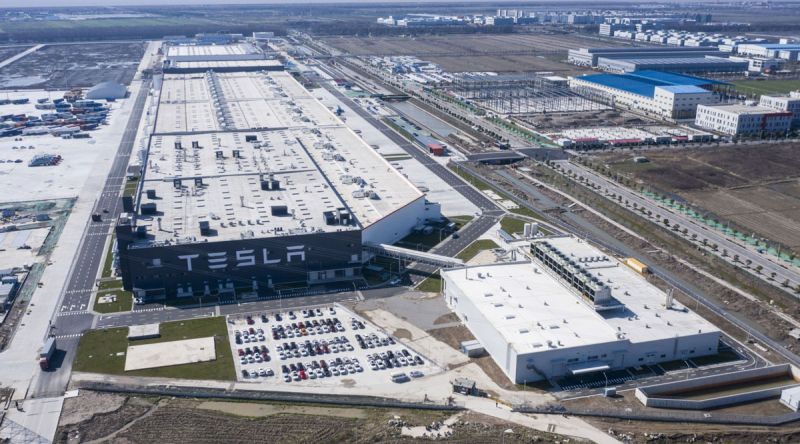Tesla Plans to Start Work on a New Plant in China to Double its Production Capacity
【Summary】Electric automaker Tesla plans to begin work on a new plant in China to double its manufacturing capacity in the world’s biggest automaker market, Reuters reported citing sources familiar with the matter. Work on the new facility could begin as early as next week.

Electric automaker Tesla plans to begin work on a new plant in China to double its manufacturing capacity in the world's biggest automaker market, Reuters reported citing sources familiar with the matter.
Work on the new facility could begin as early as next week, two people familiar with the plans told Reuters. The new plant will be located in the vicinity of Tesla's existing factory in the Lingang, Pudong New Area of Shanghai.
Tesla investment in the new facility, as well as a timetable for its completion are still unknown.
Once the plant is completed, Tesla will have the capacity to produce up to 2 million cars per year at its expanded Shanghai production base, according to the people, who asked not to be identified discussing the still-private plans. Tesla's existing Shanghai factory, which started producing cars in late 2019, has the capacity to produce 500,000 vehicles per year.
Tesla's Shanghai factory currently produces the Model 3 sedan and Model Y SUV for China and other overseas markets.
Tesla was the first foreign automaker to build a wholly owned factory after the government relaxed rules in 2018 that required foreign automakers to own no more than 50% of their joint venture partnerships with Chinese automakers. The move paved the way for Tesla to build its factory.
The ownership limit for overseas automakers was officially lifted on Jan. 1 2022. In addition, automakers are now permitted to form wholly-owned subsidiaries in China.
Tesla's Shanghai factory allows it to avoid steep import tariffs on autos, which are currently 15%. Without the tariffs, Tesla can price its electric vehicles more competitively and still make a profit.
Before the factory in China was built, Tesla exported all of the vehicles sold in China from the U.S., which were subjected to tariffs that at one point increased by 25% to 40% as a result of trade tensions between China and the former Trump administration.
China is an important market for Tesla to remain profitable. The country is the world's largest vehicle market by both annual sales and manufacturing output, with domestic production expected to reach 35 million vehicles by 2025.
Roughly 20 million passenger vehicles were sold in China in 2020, according to data from the Ministry of Industry and Information Technology.
In September 2021, Tesla completed construction of its Shanghai Supercharger factory. The facility will build the thousands of Superchargers that Tesla plans to deploy in China to support its expansion in the world's biggest auto market. The 54,000 sq ft factory includes five semi-automated assembly lines, which are capable of producing 10,000 Superchargers per year.
The facility was originally scheduled to be fully operational by June 2021, but Tesla made significant changes to the design which extended construction by an additional three months.
Tesla also has expansion plans for its existing plan from 500,000 to 1 million vehicles this year, two sources familiar with the expansion plans told Reuters. Tesla projected to take its weekly production to about 22,000 vehicles at the plant in the coming months, one of the sources said.
Tesla is also nearing completion of its factory in Germany and another in Austin, TX, which is where the company moved its headquarters. The new facilities will help Tesla meet rising demand for its vehicles in both Europe and the U.S.
Tesla delivered 936,000 vehicles in 2021, the highest ever yearly total.
resource from: Reuters
-


Ford is Testing a New Robotic Charging Station to Assist Drivers of EVs With Disabilities
-


Ford Raises the Prices of the F-150 Lightning Electric Pickup Due to Rising Raw Material Costs
-


The BMW 7-Series to Feature HD Live Maps From HERE Technologies for Hands-Free Highway Driving in North America at Speeds up to 80 MPH
-


AutoX to Use the 'Eyeonic Vision Sensor' from California-based SiLC Technologies for its Robotaxi Fleet in China
-


LG Develops ‘Invisible’ Speaker Sound Technology That Could Revolutionize In-Vehicle Audio
-


Researchers at South Korea’s Chung-Ang University Develop a ‘Meta-Reinforcement’ Machine Learning Algorithm for Traffic Lights to Improve Vehicle Throughput
-


Zeekr’s New 009 Electric Passenger Van is the World’s First EV to Feature CATL’s Advanced ‘Qilin’ Battery With a Range of 510 Miles
-


Redwood Materials is Building an Electric Vehicle Battery Recycling Facility in South Carolina
- GM Expanding First Responder Training Program for EV Crashes
- Tesla Shutters its San Mateo, CA Office, Lays Off Roughly 200 Autopilot Staff Without Notice
- Ford Motor Co is Cutting 3,000 Jobs as it Transitions to Electric Vehicles, Software and Digital Services
- Volvo’s Brand Polestar Confirms That the Polestar 6 Electric Roadster Will Enter Production and Launch in 2026
- Volvo’s Parent Company Geely Launches a New Outdoor Lifestyle EV Brand Named 'RADAR'
- Good Time to Buy Into China's EV Industry
- New Premium Electric Vehicle Brand Zeekr Is Exploring IPO Options in the U.S. or Hong Kong, According to Sources
- Apple Delays its Long Rumored Electric ‘Apple Car’ Until 2026, According to Sources
- Toyota Offering Multiple Solutions for Non-Drivable bZ4X Electric SUVs
- Biden Administration Announces New Standards to Make EV Chargers More Accessible











 About Us
About Us Contact Us
Contact Us Careers
Careers